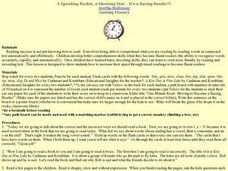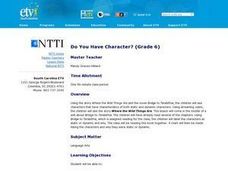Curated OER
You Can Say That Again!
A discussion of the Supreme Court’s Opinion of Tinker v. Des Moines generates a discussion of the Bill of Rights and the First Amendment. Although the key elements of this lesson plan are based on a video that is not included, the...
Curated OER
Cross-Cultural Dialogue Lesson
Students read and analyze a personal narrative written about a Peace Corps Volunteer teaching English in Guinea-Bissau, Africa. They discuss the concept of crossing cultures, analyze maps, complete worksheets, and develop a writing...
Curated OER
A Speeding Rocket, a Shooting Star... It's a Racing Reader!
Prepare a gameboard and die-cut race cars to play a fun fluency game. Also create several flash cards to review the long /i/ sound. Then, model reading smoothly and with expression, emphasizing the importance of re-reading texts to...
Curated OER
Cross-Cultural Dialogue Lesson
Use the Peace Corps to explore a different place and different perspectives. Your class reads the personal narrative "Cross-Cultural Dialogue" by Roz Wollmering, completing an attached story frame sheet in preparation for a class...
Curated OER
A Day of Infamy:Analyzing FDR’s Pearl Harbor Address
In 1941 FDR spoke out on the events at Pearl Harbor. The class will get to analyze word choice, word meaning, author's craft and structure by analyzing an actual draft of this speech. They will look critically at the words used,...
Curated OER
"The Gambler" and "The Journey": A Comparison of Worlds in Two Short Stories
“The Gambler” and “The Journey” offer readers an opportunity to experience two very different views of Jewish life in Poland between WWI and WWII. Whether used as a part of a study of the Holocaust, or as a compare/contrast exercise, the...
Curated OER
Do You Have Character?
Sixth graders read Katherine Paterson's novel, Bridge to Terabithia, and watch a video of Maurice Sendak's book, Where the Wild Things Are. They examine the characters in both stories that share similar characteristics. Students use the...
Curated OER
Totally Awesome Answers to Wacky Wonders
Middle schoolers work with a partner to gather information on a question from two sources using a computer program and the Internet. They also write a report with visuals to air on closed-circuit TV for the school. Use this lesson to...
Curated OER
Compare and Contrast Photograph Art
Take a trip down Pearblossom Highway with this lesson about comparing and contrasting. Using David Hockney's Pearblossom Hwy and another image of the same highway (photograph or other image), students compare and contrast the two...
Curated OER
History in Literature - The House of Dies Drear
Hook your learners with a great project. They research the underground railroad and civil rights movement through literature, view the video The Underground Railroad: Escape from Slavery, and read the book House of Dies Drear in their...
Curated OER
Children's Media and Censorship
High schoolers form opinions about children and television censorship after analyzing literature. They complete a journal writing activity to identify the topic and make a list of inappropriate television shows for children. Next, they...
Curated OER
Criminal or Hero
Young scholars investigate slavery in America circa the American Revolution. They will examine point- of view and perspective as they research a variety of informational resources. While this is designed to be used with the PBS video...
Curated OER
A New Life, A New Home
Fifth graders use photographs to tell the story of immigrants. They use the Internet to help them research immigration.
Curated OER
African Folktales
Students study the elements of folktales. They write, perform and produce their own African folktales using camcorders and movie software.
Curated OER
Press Conference on Hurricane Georges
Students role play a press conference on Hurricane Georges by acting as interviewers from the press. They research the impact of the hurricane in order base their questions on pertinent information. They present the press conference for...
Curated OER
To Make a Cake you must say /A/
Here is a great way for learners to practice identifying sounds made by both short and long vowels. This lesson stresses the a_e=/A/ correspondence along with letterboxes. They read their spelled words, whole text selection and...
Curated OER
Pendemonium: The Italian Job
Discover how to use prefixes and suffixes to determine the meaning of unfamiliar words. The group views a jovial video on the topic, and then they create a chart of prefix and suffix meanings to identify the meanings of words in a social...
Curated OER
The Landscape of a Novel
Young scholars, after reading a novel, utilize geographic skills to map out the places described in the novel. They collect data, envision spatial features and then design a map to work off of to complete their assignment. Each student...
Curated OER
What Lives in Water?
Students learn about a variety of sea creatures. They look at sea creatures pictures and identify the creatures by name and by their unique characteristics. Phonemic Awareness skills are reinforced using the beginning sounds of the...
Curated OER
A Modest Proposal: Irony Made Understandable with Rock and Roll
Who doesn't love music? Poems and songs will engage your high school class in a discussion about irony. Use songs like "Rockin' in the Free World" or "Born in the U.S.A." to illustrate the ironic point of view. Print the lyrics so...
Center for Civic Education
Historical Analysis of Constitutional Amendments
Each of the 27 Amendments to the U.S. Constitution were adopted within specific economic, political, social or cultural, and international contexts. As part of their Constitution Day/Week studies, seniors investigate these factors for...
Curated OER
The Art and Science of Impressionist Color
Discover Impressionist painting as students investigate the 19th century combinations of colors characteristically used. Students experiment with their own paintings, utilizing primary and secondary colors.
National Association of Writers in Education
Character and Situation
Delve into narrative writing that puts choice in the hands of the writers. Kids pick their own characters, emotions, items, and places from a list and tie them together in the exposition. Several questions help guide the writers toward...

























